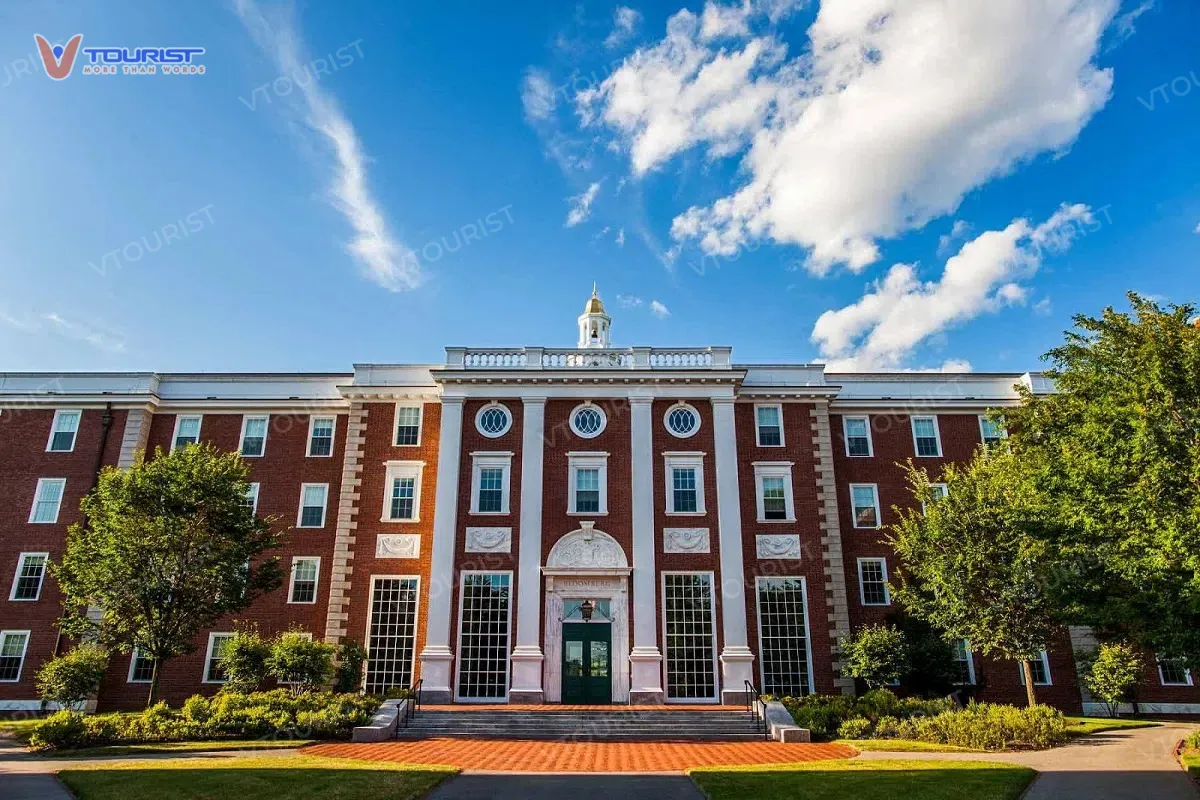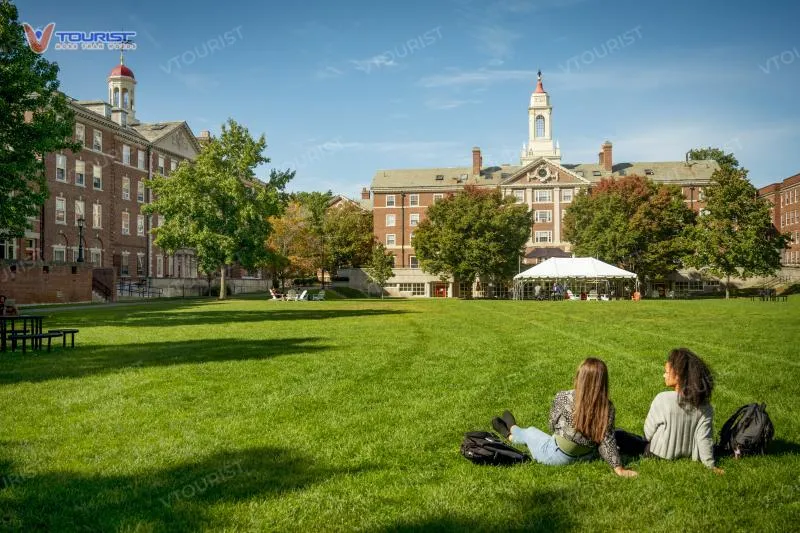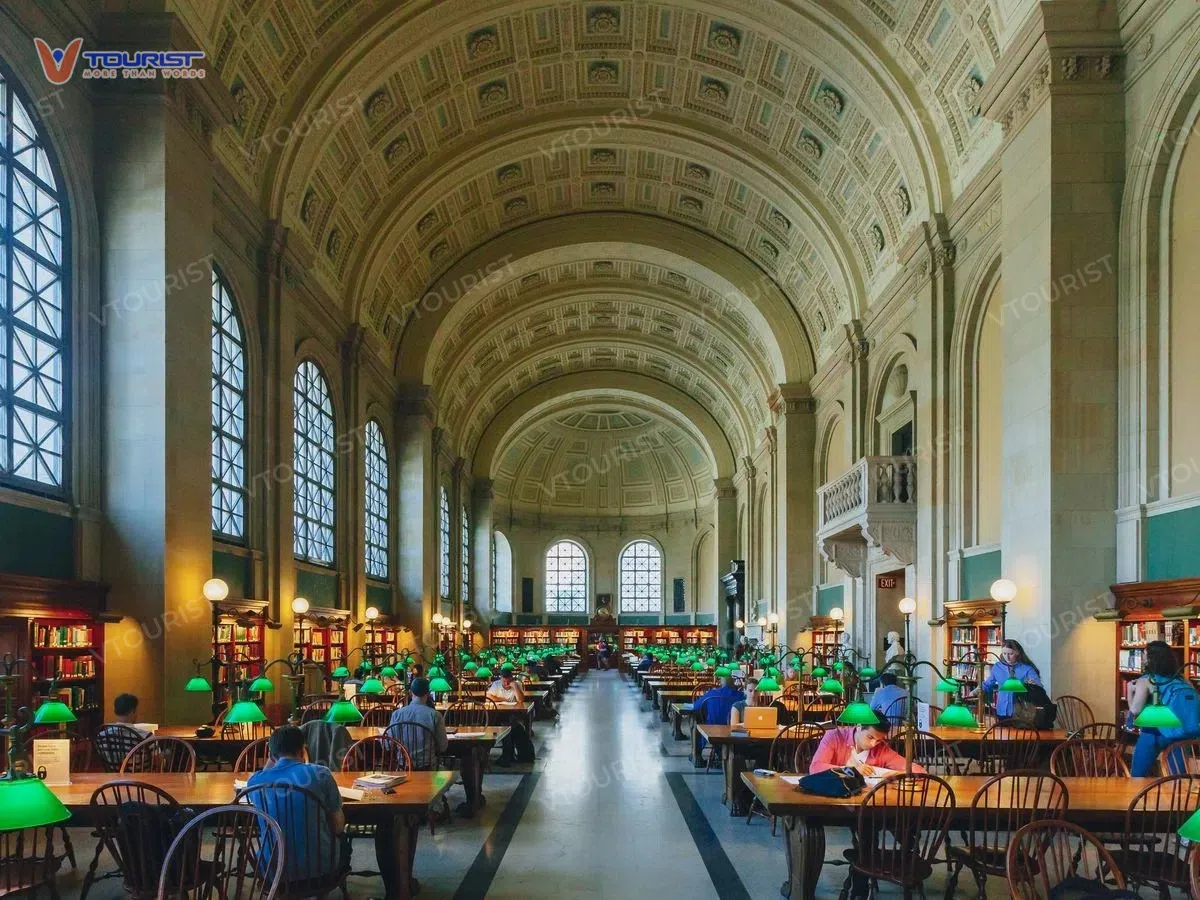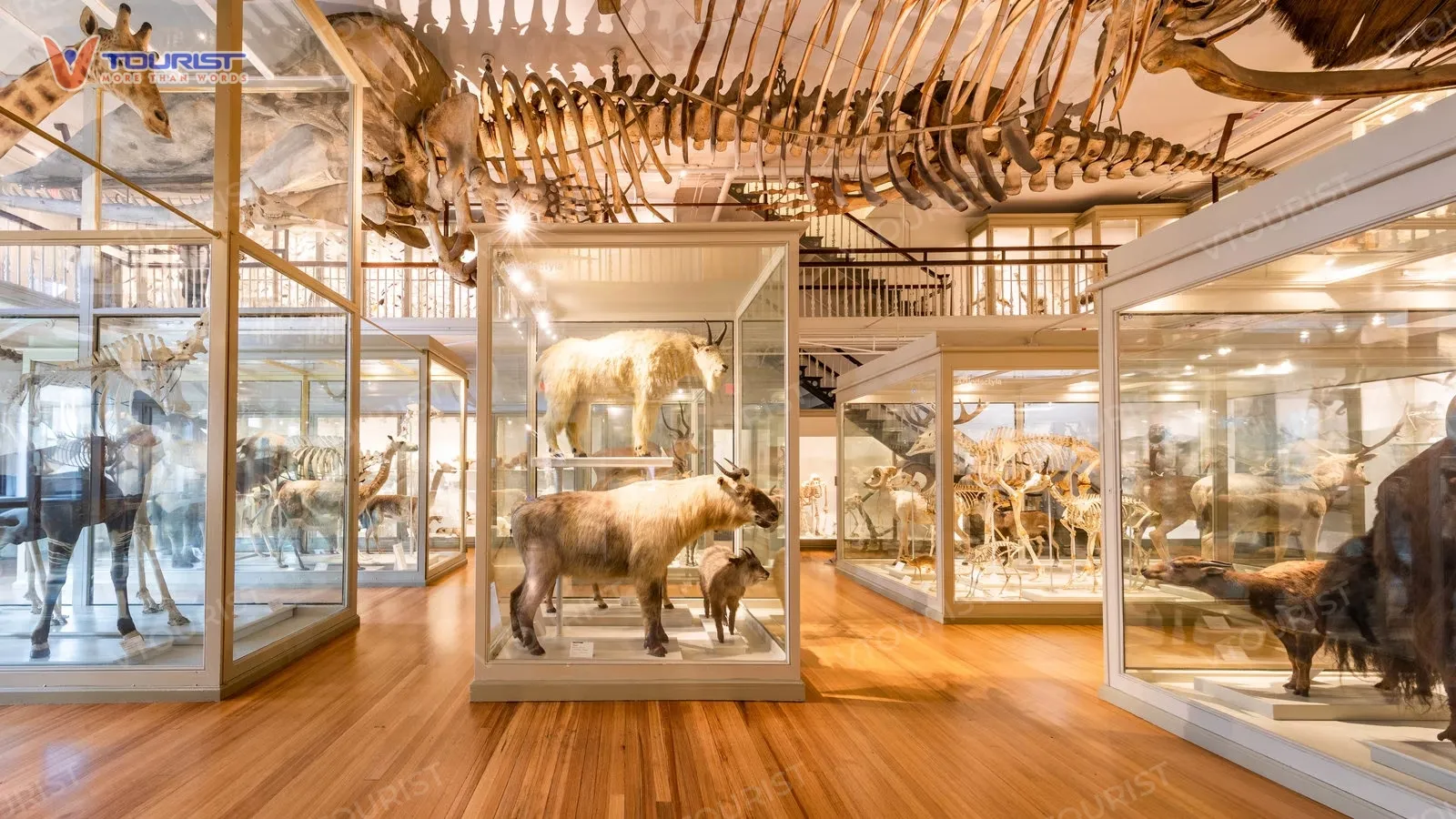Harvard University, a name that resonates globally, is not only a leading educational institution but also a symbol of knowledge and a captivating tourist destination. Located in the heart of Cambridge, Massachusetts, Harvard University offers an engaging journey of discovery, where history, architecture, and academic spirit intertwine, creating a unique and memorable experience for every visitor.
Discovering Harvard University – A Jewel of Knowledge in Massachusetts
Established in 1636, Harvard University proudly stands as one of the oldest and most prestigious institutions of higher education, not only in the United States but worldwide. Situated in the vibrant city of Cambridge, just across the Charles River from Boston, Harvard’s expansive and verdant campus is a tranquil oasis amidst the bustling urban landscape. With a rich history spanning nearly four centuries, Harvard has nurtured countless leaders, scientists, artists, and entrepreneurs who have shaped and continue to shape the modern world.
Harvard’s reputation extends across numerous fields, from medicine and law to business, social sciences, and humanities. The university boasts several world-renowned schools and faculties, including Harvard Business School, Harvard Law School, Harvard Medical School, and Harvard Kennedy School. It is an ideal place for learning and research for the most exceptional students from around the globe, with a faculty comprised of leading experts in their respective fields. Harvard also proudly counts eight U.S. Presidents among its alumni, including John Adams, John Quincy Adams, Theodore Roosevelt, Franklin Delano Roosevelt, John F. Kennedy, George W. Bush, and Barack Obama, demonstrating the university’s profound influence on American politics and society. Furthermore, over 150 Harvard alumni and faculty members have been honored with Nobel Prizes, affirming the university’s leading position in scientific research and academia.
Beyond its academic prominence, Harvard University is also an attractive tourist destination, thanks to its stunning campus featuring historic architecture and lush green spaces. Each year, millions of visitors from around the world flock to Cambridge to tour the campus, explore renowned museums and libraries, and soak in the unique academic atmosphere. A visit to Harvard University is not merely a sightseeing trip; it’s an opportunity to admire a symbol of knowledge, a precious “jewel” of Massachusetts and the world.

The History of Harvard University – From New College to Global Icon
The historical narrative of Harvard University began in 1636 when it was founded as “New College.” The initial purpose was to train ministers for the New England colony, a crucial mission in the social and religious context of that era. However, just three years later, in 1639, the institution was renamed “Harvard University” in honor of John Harvard, a significant benefactor who bequeathed half of his estate and his entire library of valuable books to the college. This contribution not only provided vital financial and intellectual resources during its nascent stage but also marked a pivotal moment in Harvard’s development, transforming it from a small college into a more substantial educational institution.
Throughout the 18th century, Harvard University underwent a profound ideological shift. From a college deeply rooted in traditionalism, Harvard gradually transitioned towards liberalism, a progressive and innovative intellectual movement. Figures like Henry Ware and Samuel Webber played crucial roles in this transformation, helping the university broaden its academic scope and embrace new ideas. By the mid-19th century, under the leadership of Charles W. Eliot, Harvard continued to implement extensive reforms, removing religious influence from the curriculum and focusing more on developing individual character and intellectual freedom for students.
Entering the 20th century, Harvard University embarked on a period of extraordinary growth, solidifying its position on the international stage. Student enrollment and research scale increased significantly. President James Bryant Conant, who led the university from 1933 to 1953, made substantial contributions to promoting innovative education and expanding access to education for talented students, regardless of their background. Another significant milestone in Harvard’s history was the formal merger of Radcliffe College, a women’s college, into Harvard in 1999, marking a crucial step towards gender equality in education. In 2007, Drew Gilpin Faust became the first female president of Harvard University, a historic event reflecting the university’s evolving inclusivity and progress.
Today, Harvard University continues to thrive and maintain its status as one of the world’s leading universities. Its long history, tradition of academic excellence, constant innovation, and commitment to diversity have shaped a unique Harvard, a global symbol of knowledge that anyone would aspire to explore and experience.

Harvard University Architecture – A Harmony of Classic and Modern
The architecture of Harvard University is a magnificent symphony of classic beauty and modernity, reflecting the university’s long history and innovative spirit. Upon entering the Harvard campus, visitors are immediately struck by the diversity of architectural styles, from historic red-brick buildings to bold, modern structures.
Harvard Yard, the central campus, is home to many historical buildings dating from the 17th to 19th centuries. Buildings like Massachusetts Hall, Harvard Hall, and Stoughton Hall exhibit distinctive colonial architectural styles, with red bricks, symmetrical windows, and pitched roofs, creating a solemn and antique ambiance. Memorial Hall, completed in 1878, exemplifies the Gothic Revival style, with pointed arches, stained glass windows, and towering spires, reminiscent of ancient European cathedrals. This structure is not only an aesthetically beautiful work but also holds deep historical significance, built to commemorate Harvard alumni who sacrificed their lives in wars.
However, Harvard University does not merely preserve traditional architectural values but also continuously innovates and develops. The Harvard Science Center, completed in 1973 and designed by renowned architect I.M. Pei, is a clear testament to the integration of modern architecture and academic space. This building stands out with its Brutalist architectural style, primarily using concrete and glass, creating a powerful and contemporary aesthetic. The Science Center not only serves scientific research activities but has also become a symbol of innovation and creativity in Harvard’s architecture.
The harmonious blend of classic and modern architecture creates a unique and captivating environment at Harvard University. Each building and every corner of the campus tells a story of the university’s history, culture, and academic ethos. A tour of Harvard is not just an architectural sightseeing trip but also a journey to explore the continuous evolution of education and culture through centuries.

Exploring Harvard University Campus – Must-See Destinations
A tour of Harvard University will take you through many fascinating destinations, each with its own unique beauty and significance. Here are some must-visit spots when exploring the campus:
Harvard Square – The Heart of Campus
Harvard Square is a vibrant and bustling area, considered the center of student life and the surrounding community. Located just outside the main gates of Harvard Yard, the square is a crossroads of numerous streets, shops, cafes, bookstores, and cinemas. It is an ideal starting point for exploring Harvard, where you can feel the dynamic rhythm of this university city. Harvard Square is not only a gathering and entertainment spot but also the hub of daily activities for the Harvard community, from cultural events and street music to protests and political activities.
Another distinctive feature of Harvard Square is its own subway station (the “T”), making it easy and convenient to travel to and from other parts of the city. The combination of historical space, modern amenities, and a lively atmosphere has made Harvard Square an unmissable destination on any Harvard University tour.
Harvard Yard and the John Harvard Statue – School Icons
Harvard Yard, the green heart of Harvard University, is a peaceful and solemn space enclosed by iron fences, brick walls, and ancient gates. Established in the late 17th century, Harvard Yard is the oldest part of the campus, housing many important historical buildings. Covering a large area of about 25 acres, Harvard Yard is not only a living and learning space for freshmen but also a tourist attraction due to its architectural beauty and lush greenery.
Prominently located in Harvard Yard is the John Harvard Statue, an indispensable symbol of the university. The statue stands on a high stone pedestal, attracting many visitors to admire and take souvenir photos. However, interestingly, this statue is often called the “Statue of Three Lies” because it does not actually depict John Harvard (no one knows his exact appearance), the founding year inscribed on the statue is 1638 (actually 1636), and John Harvard was not the founder but merely a benefactor. Despite this, the statue remains an important symbol, reminding us of John Harvard’s contribution and the university’s history.
Harvard Yard also hosts many important university events, including annual graduation ceremonies, outdoor concerts, and other cultural activities. Especially in the fall, Harvard Yard dons a brilliant golden coat of maple leaves, creating a romantic and stunning scene, attracting many tourists to visit and admire.

Widener Library – A Priceless Treasury of Knowledge
Widener Library, majestically situated on the eastern side of Harvard Yard, just behind the John Harvard Statue, is one of the largest and most significant academic libraries in the world. Considered the intellectual heart of Harvard University, Widener Library is not only home to a vast collection of books but also an architecturally stunning building, a symbol of respect for knowledge and academia.
The library was built thanks to a financial contribution from Eleanor Elkins Widener, mother of Harry Elkins Widener, a Harvard alumnus and passionate book collector. Harry tragically died in the Titanic disaster in 1912, and the library was named in his memory. With over 3.5 million volumes and millions of other documents, Widener Library is a priceless treasure trove of knowledge, providing rich resources for Harvard students, faculty, and researchers. The library’s architecture is in the Beaux-Arts style, with a white granite facade, classical Greek columns, and a soaring domed roof, creating a solemn and magnificent beauty. Widener Library is not only a place for study and research but also an attractive destination for visitors who want to admire its architectural splendor and experience the unique intellectual atmosphere.

Memorial Hall and Sanders Theatre – Historical Witnesses
Memorial Hall is an impressive architectural structure located north of Harvard Yard, near the intersection of Cambridge, Kirkland, and Quincy Streets. Built in 1878 in the High Victorian Gothic style, Memorial Hall is one of Harvard University’s most prominent architectural icons. With features such as brilliant stained glass windows, ribbed vaults, towering spires, and intricate decorative details, the building is not only aesthetically striking but also carries much historical and cultural significance. Memorial Hall was built to commemorate Harvard alumni who died in the American Civil War, and it stands as a testament to the patriotism and sacrifice of Harvard’s sons.
Memorial Hall comprises three main sections: Sanders Theatre, Annenberg Hall, and Memorial Transept. Among these, Sanders Theatre is Harvard University’s largest indoor space, a significant venue for major university events. It hosts important lectures, concerts, award ceremonies, and especially Harvard’s annual commencement ceremony. Sanders Theatre has also welcomed many world-renowned figures, from Winston Churchill and Martin Luther King Jr. to Theodore Roosevelt and Bill Gates, who have come here to speak and share meaningful messages.
Memorial Transept is an open sanctuary space with a high vaulted ceiling and large stained glass windows, creating a sacred and solemn atmosphere. It is an ideal spot to admire the architectural beauty and take souvenir photos, especially when sunlight streams through the stained glass windows, creating stunning light effects. Although Harvard students are generally not allowed inside Sanders Theatre except for special events, visitors can still tour and explore the architectural beauty and historical significance of Memorial Hall, a vital historical witness of Harvard University.

Annenberg Hall – Gothic Beauty and Harry Potter Inspiration
Annenberg Hall, located inside Memorial Hall, is a magnificent and impressive architectural space, often likened to the Great Hall in the famous Harry Potter movies. Built in 1874, Annenberg Hall was originally designed as a large dining hall for students and was one of the largest meeting rooms in the United States at the time. With its distinctive Gothic architecture, the hall is notable for its soaring stained glass windows, intricately carved wooden beams, and high vaulted ceiling. Annenberg Hall’s lighting system is highlighted by large chandeliers and walls decorated with portraits of university benefactors and presidents.
Today, Annenberg Hall remains a dining hall, but it is exclusively for Harvard freshmen. The hall’s spacious, magnificent, and elegant atmosphere creates a special ambiance, making each meal a memorable experience. Interestingly, the Gothic architectural beauty of Annenberg Hall has indeed inspired the design of the Great Hall in the Harry Potter films, providing a fascinating link between prestigious Harvard University and the magical wizarding world.
Harvard Museum of Natural History – Discovering a Diverse World
The Harvard Museum of Natural History, located north of the Harvard Science Center, is a captivating destination for those who love to explore the natural world and history. The museum showcases a diverse and rich collection of artifacts, from giant dinosaur fossils to rare wildlife, from exquisite glass flower collections to sparkling mineral and gemstone specimens.
One of the museum’s highlights is the fossil skeleton of Kronosaurus, a prehistoric marine reptile up to 42 feet long. In addition, the museum features collections of birds, insects, mammals, plants, and microbes, providing a comprehensive view of the diversity of life on Earth. The Ware Collection of Blaschka Glass Models of Plants is another unique highlight of the museum, including thousands of intricately crafted glass flowers, vividly and realistically mimicking the beauty of the plant world. The Harvard Museum of Natural History is not only a place for displaying artifacts but also an educational and research center where visitors can learn about natural history, science, and conservation. The museum entrance ticket also includes admission to Harvard’s Peabody Museum of Archaeology and Ethnology, further expanding your journey of cultural and historical discovery.

Conclusion – Harvard University, A Must-Visit Destination on the Journey of Knowledge
A visit to Harvard University is not just a trip to explore a famous tourist site but a profound experience of history, culture, and knowledge. From the ancient campus with unique architecture to museums and libraries holding priceless treasures of knowledge, Harvard offers a diverse and enriching journey of discovery. Whether you are a prospective student, a parent interested in education, or simply a traveler who loves to explore, Harvard University always welcomes you and provides memorable experiences on your quest for knowledge and beauty. Come and feel the academic spirit, architectural beauty, and special atmosphere of Harvard University, a symbol of knowledge in Massachusetts and the world.